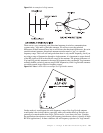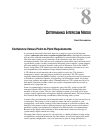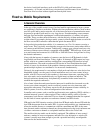
Chapter 8 - Determining Intercom Needs 115
the choice, but digital interfaces, such as the SSA424, yield good intersystem
transparency. As a result, an initial two-wire purchase can interconnect to an ADAM or
Zeus four-wire host later without significant trans-hybrid losses.
Fixed vs. Mobile Requirements
A General Overview
In the age of the portable control room, fixed and mobile requirements in larger systems
are surprisingly similar to each other. Within television production vehicles, such as those
used for sports and by major networks, all of the intercom forms of communication must
be present to produce from small, to very large shows. Notwithstanding, some contrasts
between fixed and mobile requirements could include quantities of cameras, belt packs,
and IFBs. There are other minor differences, with the majority of them mechanical and
weight related. For example, placing a matrix system in a truck might be better served with
the more secure DE9 connector rather than the quick disconnect RJ12.
In large television production vehicles, it is common to see 12 to 16 cameras covering a
major event. This is typically more than the average television news station where three to
six cameras would be more common. Traditionally, cameras were voltage based two-wire,
and most of them were not directly compatible with the RTS
™
TW intercom. A belt pack
was used instead and connected to a SAP1026 or SAP1626 Source Assign Panel to set up
the desired conferences.
Along with the increase in number of cameras came the boost in IFB channels in both
large mobile and fixed installations. Today, eight to 16 channels of IFB output in a large
mobile vehicle are common and have matched the corresponding IFB increase in large
fixed installations. The trend toward more IFB circuits in fixed installations has been
fueled, of course, by the advent of the portable videotape camera and microwave links that
permit multiple reporters to contribute to live newscasts simultaneously.
Curiously, the requirement for vast numbers of belt packs and other two-wire devices has
diminished slightly over the years for fixed installations and, to a lesser extent, in large
mobile vehicles. One reason for this tendency is that camera intercoms, operating in the
four-wire mode, can be attached directly to a digital matrix without an interface. The
desired conference channels may be dynamically assembled in the central matrix to
establish the required conferences.
Also of note is that the trend toward matrix intercom for mobiles has increased over the
last ten years when customarily, trucks would only contain two-wire intercoms with
appropriate subsystems. The primary reason for this development is better reliability in
matrix systems, as well as, easier reconfiguration of the intercom.
In smaller truck systems, such as satellite and electronic news gathering (ENG) vehicles, a
minimal intercom system is often required. These vehicles usually consist of just the
cameraman, local director, and talent. The two forms of communication that are required
for this kind of remote operation are conference channels and IFB circuits.
IFB used in the ENG situation consists of both local IFB and studio director IFB with the
local IFB downstream from the studio IFB. A system configured this way simultaneously
allows the mobile director to communicate with the cameraman and IFB. At the same
time, the main studio conference channel may be superimposed on the local conference net
via either a microwave channel or a telephone interface such as the Telos Link.
The smaller television studio can be similarly equipped. The addition of more control
stations, a method of source assignment, and more two-wire belt packs or wireless PL
systems is usually more than enough to provide a powerful and easily reconfigurable
intercom for the smaller market.


















